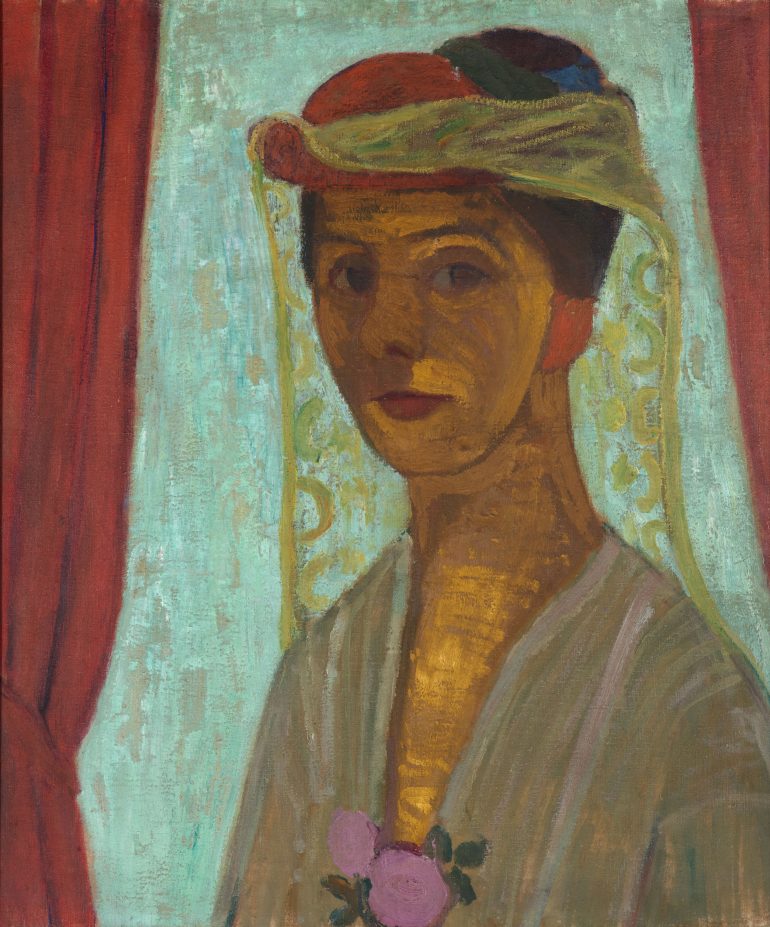Out of the shadow falling across her face, Paula Modersohn Becker regards us with a steady gaze. She painted Self-portrait with Hat and Veil in the early years of the twentieth century, after a period of great uncertainty about what direction her life should take: a future with her husband, painter Otto Modersohn in Worpswede, Germany, striking the best possible balance between the life of an artist and motherhood; or complete devotion to art amid the excitement of Paris. She chose the former. Her depiction of motherhood and her self-portraits were groundbreaking.
Kunstmuseum Den Haag has been working on the restoration of Self-portrait with Hat and Veil for some time. The highlight of the collection has been examined, cleaned and reframed. Now, in collaboration with the Rembrandt Association and the Turing Foundation, the spotlight is focusing on the artist herself. In an exhibition in the intimate Berlage Room, she will occupy the place of honour alongside fellow female artists Suze Robertson, Jacoba van Heemskerck and Käthe Kollwitz.
A restless existence
Paula Becker was part of the Worpswede artists’ colony from around 1897. It was there that she met painter Otto Modersohn. Inspired by their rural surroundings, Otto and many of the other artists there painted colourful landscapes. Paula also focused on the people who lived in the village. Mothers and children were her favourite subjects, portrayed either separately or together. In 1901 she married Otto, and became stepmother to his daughter Elsbeth. In Worpswede, Paula longed for Paris, where she spent several extended periods from 1900 onwards, enjoying the adventure of the big city. In Worpswede she enjoyed the peace and quiet of family life.
In Self-portrait with Hat and Veil we see Modersohn-Becker in complete harmony with herself. By now, she had managed to reconcile desires that had previously seemed incompatible. In early 1906 she had left for Paris, intending to divorce her husband and devote herself entirely to art, but by the time she completed this painting she had changed her mind. She was back with Otto Modersohn and pregnant, fully convinced that she could live her life as a mother and woman as she saw fit. Their daughter Mathilde was born on 2 November 1907, but Paula’s happiness was not to last long: she died of an embolism on 20 November. Her final words were ‘What a pity’.
Groundbreaking art
‘The female nude’ and ‘mother and child’ are traditional themes in art. In the early twentieth century they were depicted mainly as seen by the male gaze – sexually charged, or sweet and charming, or both. Paula Modersohn-Becker broke with this tradition, producing a host of nude self-portraits and portraits of mothers with their newborn children that evoke an entirely different sensation. Modersohn-Becker’s nude portraits are based on her own experiences and those of other women. They are at once powerful, raw and vulnerable. As such, they provided the basis for later art guided by the female experience.
Paula’s voice
Alongside the exhibition in the museum itself, Kunstmuseum Den Haag also has a great deal of online material on Paula Modersohn-Becker. In the midst of the Covid-19 pandemic, not everyone is willing or able to visit the museum, so the museum is experimenting with storytelling and displaying the collection via online channels. Kunstmuseum Den Haag has posted a short film that gives Paula a voice of her own. In a fictional monologue written by Renée van Marissing and performed by Soumaya Ahouaoui, she expresses her doubts and describes her passions and motives. The museum is also providing some art-historical background in the form of an article in which curator Laura Stamps discusses Modersohn-Becker’s self-portraits in relation to self-portraits by contemporary female artists, like Paula Rego and Charlotte Joffa.
